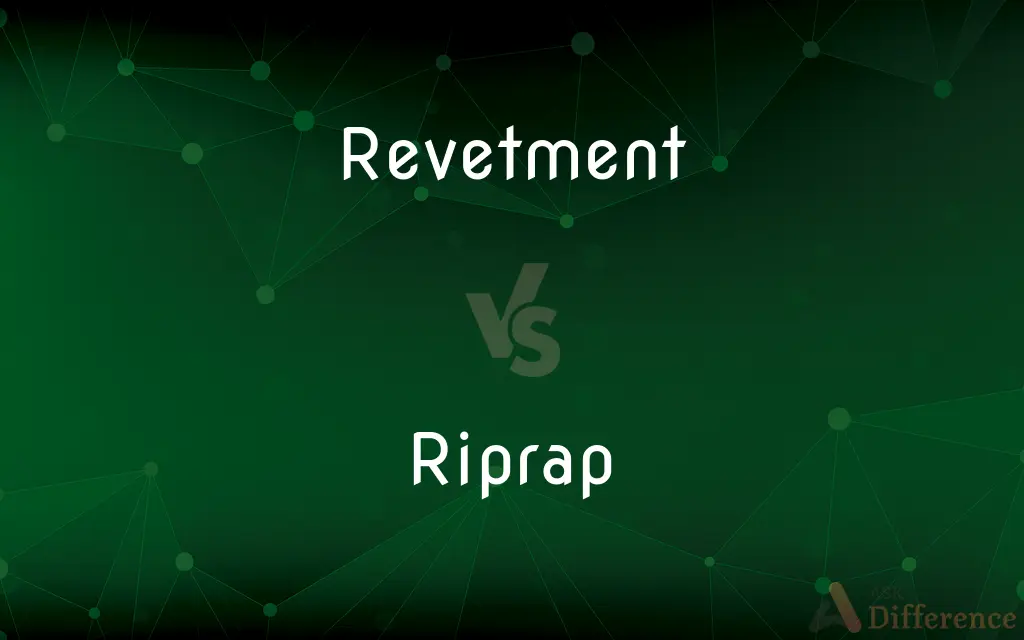Revetment vs. Riprap — What's the Difference?
Edited by Tayyaba Rehman — By Maham Liaqat — Updated on March 29, 2024
Revetment is a protective covering on slopes or embankments to prevent erosion, while riprap consists of loose stones used to stabilize shorelines, banks, or slopes.

Difference Between Revetment and Riprap
Table of Contents
ADVERTISEMENT
Key Differences
Revetment is a broader term for structures designed to protect slopes, embankments, or shorelines from erosion, typically made from concrete, wood, rocks, or other materials, and placed along banks or coasts to absorb and deflect the energy of water. Riprap, a form of revetment, specifically refers to the placement of large, loose stones or rubble along shorelines, riverbanks, or slopes to prevent soil erosion by water.
While revetment encompasses a range of materials and methods for erosion control, riprap is characterized by its use of irregularly sized rocks placed together without an organizing binder. Revetments can include various engineering solutions, such as geotextiles, concrete mats, or vegetated systems, aimed at providing long-term stabilization and protection against erosion. Riprap, on the other hand, relies on the natural interlocking of rocks to create a permeable, flexible barrier against water flow, reducing erosion and promoting stability.
The choice between revetment and riprap often depends on specific site conditions, including the level of erosion threat, environmental considerations, and budget constraints. Revetments are suitable for areas needing more structured protection, while riprap offers a cost-effective solution for areas where flexibility and permeability are desired.
Both revetment and riprap serve crucial roles in protecting infrastructure and natural landscapes from the damaging effects of erosion. However, their effectiveness, environmental impact, and aesthetic considerations can vary, making it important to choose the appropriate method based on comprehensive site assessments.
Comparison Chart
Definition
A protective covering used to prevent erosion.
Large, loose stones used to stabilize and protect slopes.
ADVERTISEMENT
Material
Concrete, wood, rocks, geotextiles.
Irregularly sized rocks or rubble.
Application
Slopes, embankments, shorelines.
Shorelines, riverbanks, slopes.
Construction
Can be structured or layered.
Consists of randomly placed stones.
Functionality
Absorbs and deflects energy of water.
Promotes stability through natural interlocking of stones.
Compare with Definitions
Revetment
Used in diverse environments.
Revetments are critical for maintaining the integrity of roadway embankments.
Riprap
Offers flexibility and permeability.
Riprap allows water to flow through, reducing pressure on the embankment.
Revetment
Often involves engineering solutions.
The engineered revetment system included drainage layers to prevent water buildup.
Riprap
Cost-effective erosion control solution.
Choosing riprap for the slope stabilization was both economical and effective.
Revetment
Can be made from a variety of materials.
The riverbank was reinforced with a geotextile revetment.
Riprap
A form of revetment consisting of loose, large stones.
Riprap was placed along the riverbank to prevent further erosion.
Revetment
A protective structure designed to prevent erosion and protect shorelines.
The coastal town installed a concrete revetment to protect its beaches.
Riprap
Characterized by the use of irregularly sized rocks.
The riprap varied in size to ensure a natural, interlocking fit.
Revetment
Provides long-term stabilization.
The newly installed revetment will safeguard the coastal area for decades.
Riprap
Used to protect soil from erosion by water.
The bridge foundation was secured with riprap to handle storm surges.
Revetment
Revetments in stream restoration, river engineering or coastal engineering, are sloping structures placed on banks or cliffs in such a way as to absorb the energy of incoming water. In military engineering they are sloped structures formed to secure an area from artillery, bombing, or stored explosives.
Riprap
Riprap (in North American English), also known as rip rap, rip-rap, shot rock, rock armour (in British English) or rubble, is human-placed rock or other material used to protect shoreline structures against scour and water, wave, or ice erosion. Ripraps are used to armor shorelines, streambeds, bridge abutments, foundational infrastructure supports and other shoreline structures against erosion.
Revetment
A facing, as of masonry, used to support an embankment.
Riprap
Piled broken stones used as a foundation or to stabilize an easily eroded bank or slope.
Revetment
A barricade against explosives.
Riprap
An assemblage of such broken stones.
Revetment
A layer of stone, concrete, or other hard material supporting the side of an embankment.
Riprap
To construct a riprap in or on.
Revetment
An ornamental facing, as on a common masonry wall, of marble, face brick, tiles, etc.
Riprap
To strengthen with a riprap.
Revetment
An armoured building that provides protection against bombs.
Riprap
An underwater bank seen as a danger to shipping.
Revetment
A facing of wood, stone, or any other material, to sustain an embankment when it receives a slope steeper than the natural slope; also, a retaining wall.
Riprap
Rocks or other materials used to shore up an embankment, deter or prevent erosion, guide shipping, or serve as a temporary mooring.
Revetment
A barrier against explosives
Riprap
To form a riprap in or upon.
Revetment
A facing (usually masonry) that supports an embankment
Riprap
A foundation or sustaining wall of stones thrown together without order, as in deep water or on a soft bottom, or in a river channel.
Riprap
To form a riprap in or upon.
Common Curiosities
What are the main benefits of using revetment?
Revetments absorb wave energy, protect shorelines from erosion, and can be tailored to specific environmental and aesthetic needs.
Can revetment and riprap be used together?
Yes, in some projects, riprap is used as part of a larger revetment strategy to provide additional stability and protection.
What factors influence the selection of materials for revetment projects?
Factors include the level of exposure to wave and wind action, budget, environmental impact, and the desired lifespan of the protection.
How do environmental considerations affect the choice between revetment and riprap?
Environmental considerations include the potential impact on local habitats and water flow, with riprap often preferred in sensitive areas due to its natural appearance and permeability.
Why is riprap considered an effective erosion control method?
Riprap is effective due to its flexibility, permeability, and ability to conform to the landscape, providing natural protection against erosion.
Are there any innovative materials being used in revetment construction?
Yes, innovations include the use of eco-friendly geotextiles, recycled materials, and engineered living structures that incorporate vegetation.
Can the use of revetment or riprap affect beach access?
It can, depending on the design and location. Careful planning is necessary to balance erosion control with public access and use.
How do engineers decide between using revetment or riprap for a project?
Engineers consider factors such as site-specific erosion patterns, wave energy, budget constraints, and environmental impact assessments to decide.
What challenges are faced during the installation of revetment and riprap?
Challenges include logistical issues in transporting materials, ensuring stability and effectiveness, and minimizing environmental disruption.
How does riprap prevent erosion?
Riprap prevents erosion by dissipating the energy of flowing water or waves, reducing the speed of water flow, and stabilizing the soil with its weight.
What maintenance is required for revetment and riprap?
Maintenance may involve replacing or repositioning displaced materials, controlling vegetation growth, and ensuring drainage systems remain effective.
How do riprap and revetment solutions adapt to rising sea levels and climate change?
Solutions are increasingly designed to be more resilient and adaptable, incorporating flexible materials and accommodating predicted changes in sea levels and weather patterns.
How do revetment and riprap impact local wildlife?
The impact varies; while they can provide habitats for certain species, they can also disrupt local ecosystems. Design and material choice are critical for minimizing negative impacts.
How is the success of revetment and riprap measures evaluated?
Success is evaluated based on longevity, effectiveness in preventing erosion, minimal environmental impact, and maintenance requirements.
What role does government regulation play in the installation of revetment and riprap?
Government regulations aim to ensure that erosion control measures do not harm the environment or public safety, requiring permits and compliance with environmental standards.
Share Your Discovery

Previous Comparison
Amoeba vs. Hydra
Next Comparison
Race vs. RacismAuthor Spotlight
Written by
Maham LiaqatEdited by
Tayyaba RehmanTayyaba Rehman is a distinguished writer, currently serving as a primary contributor to askdifference.com. As a researcher in semantics and etymology, Tayyaba's passion for the complexity of languages and their distinctions has found a perfect home on the platform. Tayyaba delves into the intricacies of language, distinguishing between commonly confused words and phrases, thereby providing clarity for readers worldwide.














































